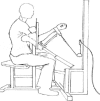Dynamic training volume: a construct of both time under tension and volume load
- PMID: 24357968
- PMCID: PMC3861774
Dynamic training volume: a construct of both time under tension and volume load
Abstract
The purpose of this study was to investigate the effects of three different weight training protocols, that varied in the way training volume was measured, on acute muscular fatigue. Ten resistance-trained males performed all three protocols which involved dynamic constant resistance exercise of the elbow flexors. Protocol A provided a standard for the time the muscle group was under tension (TUT) and volume load (VL), expressed as the product of the total number of repetitions and the load that was lifted. Protocol B involved 40% of the TUT but the same VL compared to protocol A; protocol C was equated with protocol A for TUT but only involved 50% of the VL. Fatigue was assessed by changes in maximum voluntary isometric force and integrated electromyography (iEMG) between the pre- and post-training protocols. The results of the study showed that, when equated for VL, greater TUT produced greater overall muscular fatigue (p ≤ 0.001) as reflected by the reduction in the force generating capability of the muscle. When the protocols were equated for TUT, greater VL (p ≤ 0.01) resulted in greater overall muscular fatigue. All three protocols resulted in significant decreases in iEMG (p ≤ 0.05) but they were not significantly different from each other. It was concluded that, because of the importance of training volume to neuromuscular adaptation, the training volume needs to be clearly described when designing resistance training programs. Key PointsIncrease in either time under tension (TUT) or volume load (VL) increases the acute fatigue response, despite being equated for volume (by another method).A potential discrepancy in training volume may be present with training parameters that fail to control for either TUT or VL.Neural fatigue may be a contributing factor to the development of muscular fatigue but is not influenced by various methods of calculating volume such as TUT or VL.
Keywords: Resistance training; electromyography; fatigue; maximal voluntary contraction.
Figures




Similar articles
-
The effects of varying time under tension and volume load on acute neuromuscular responses.Eur J Appl Physiol. 2006 Nov;98(4):402-10. doi: 10.1007/s00421-006-0297-3. Epub 2006 Sep 13. Eur J Appl Physiol. 2006. PMID: 16969639 Clinical Trial.
-
Muscle Thickness, Echo-Intensity, Peak Force, Time Under Tension, Total Load Lifted, and Perception of Effort Comparisons Between Two Abdominal Crunch Resistance Training Protocols in Recreationally-Trained Participants.Int J Exerc Sci. 2023 May 1;16(6):538-549. doi: 10.70252/BCSY3591. eCollection 2023. Int J Exerc Sci. 2023. PMID: 37621710 Free PMC article.
-
Acute physiological responses with varying load or time under tension during a squat exercise: A randomized cross-over design.J Sci Med Sport. 2021 Feb;24(2):171-176. doi: 10.1016/j.jsams.2020.07.015. Epub 2020 Aug 6. J Sci Med Sport. 2021. PMID: 32792317 Clinical Trial.
-
Comparison of methods to quantify volume during resistance exercise.J Strength Cond Res. 2009 Jan;23(1):106-10. doi: 10.1519/jsc.0b013e31818efdfe. J Strength Cond Res. 2009. PMID: 19130641 Clinical Trial.
-
Monitoring the training dose and acute fatigue response during elbow flexor resistance training using a custom-made resistance band.PeerJ. 2020 Feb 25;8:e8689. doi: 10.7717/peerj.8689. eCollection 2020. PeerJ. 2020. PMID: 32140314 Free PMC article.
Cited by
-
Exercise prescription variables predict reductions in pain intensity in adults with chronic low back pain: secondary analysis of a randomised controlled trial.BMJ Open Sport Exerc Med. 2024 Jan 5;10(1):e001744. doi: 10.1136/bmjsem-2023-001744. eCollection 2024. BMJ Open Sport Exerc Med. 2024. PMID: 38196942 Free PMC article.
-
Can Post-Activation Performance Enhancement (PAPE) Improve Resistance Training Volume during the Bench Press Exercise?Int J Environ Res Public Health. 2020 Apr 8;17(7):2554. doi: 10.3390/ijerph17072554. Int J Environ Res Public Health. 2020. PMID: 32276452 Free PMC article. Clinical Trial.
-
The Influence of Movement Tempo During Resistance Training on Muscular Strength and Hypertrophy Responses: A Review.Sports Med. 2021 Aug;51(8):1629-1650. doi: 10.1007/s40279-021-01465-2. Epub 2021 May 27. Sports Med. 2021. PMID: 34043184 Free PMC article. Review.
-
Force-velocity, impulse-momentum relationships: implications for efficacy of purposefully slow resistance training.J Sports Sci Med. 2008 Jun 1;7(2):299-304. eCollection 2008. J Sports Sci Med. 2008. PMID: 24149464 Free PMC article.
-
The majority are not performing home-exercises correctly two weeks after their initial instruction-an assessor-blinded study.PeerJ. 2015 Jul 21;3:e1102. doi: 10.7717/peerj.1102. eCollection 2015. PeerJ. 2015. PMID: 26244112 Free PMC article.
References
-
- Allen D.G. (2004) Skeletal muscle function: Role of ionic changes in fatigue, damage and disease. Clinical and Experimental Pharmacology and Physiology 31, 485-493 - PubMed
-
- Behm DG Reardon G., Fitzgerald J., Drinkwater E. (2002) The effect of 5, 10, and 20 repetition maximums on the recovery of voluntary and evoked contractile properties. Journal of Strength and Condition Research 16, 209-218 - PubMed
-
- Benedict T. (1999) Manipulating resistance training program variables to optimize maximum strength in men: A review. Journal of Strength and Conditioning Research 13, 289-304
-
- Benson C., Docherty D., Brandenburg J. (2006) Acute neuromuscular responses to resistance training performed at 100% and 90% of 10RM. Journal of Science and Medicine in Sports 9, 135-142 - PubMed
-
- Dimitrova N.A., Dimitrov G.V. (2003) Interpretation of EMG changes with fatigue: facts, pitfalls, and fallacies. Journal of Electromyography and Kinesiology 13, 13-36 - PubMed
LinkOut - more resources
Full Text Sources
